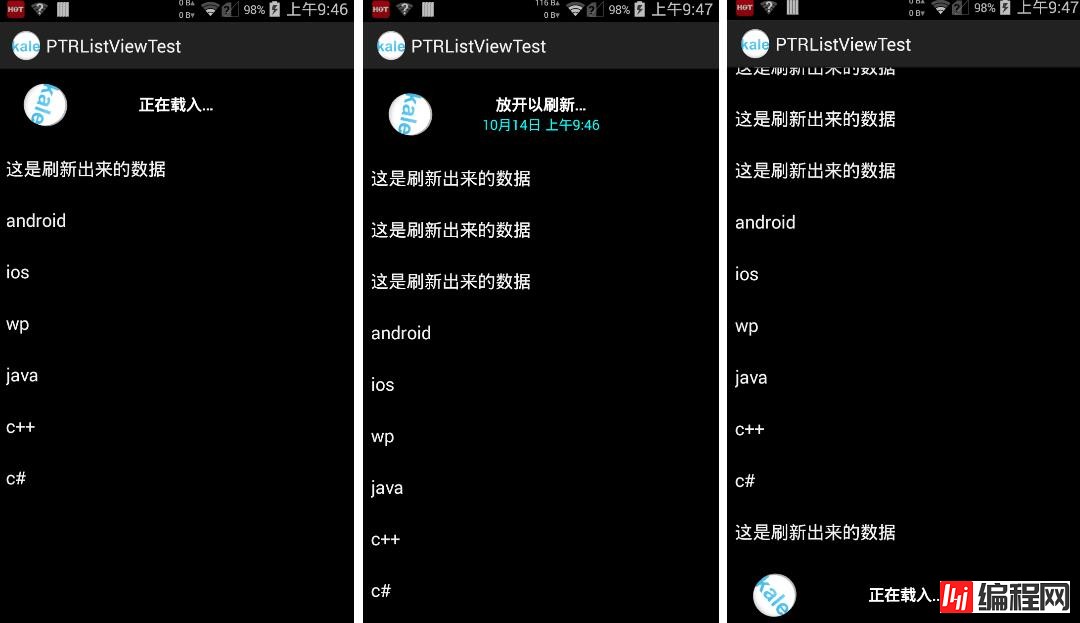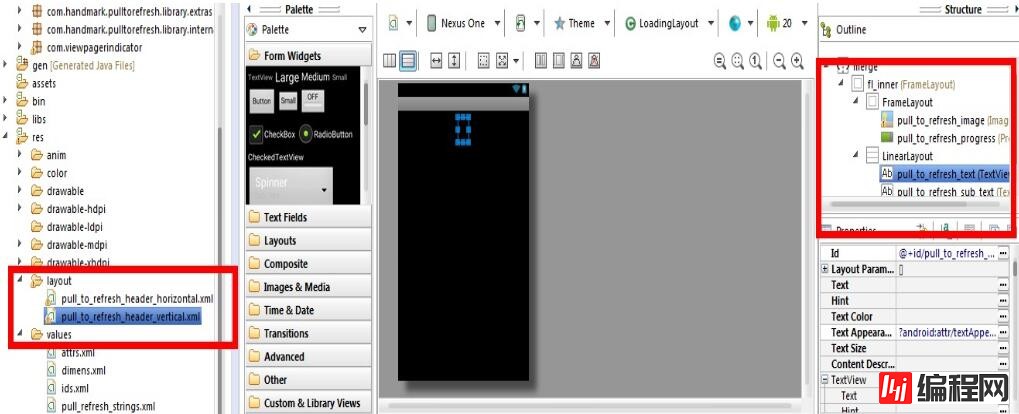先看看效果图: 开源项地址:https://GitHub.com/chrisbanes/Android-PullToRefresh 下拉刷新这个功能我们都比较常
先看看效果图:

开源项地址:https://GitHub.com/chrisbanes/Android-PullToRefresh
下拉刷新这个功能我们都比较常见了,今天介绍的就是这个功能的实现。我将按照这个开源库的范例来一点一点介绍,今天是介绍比较常见的PullToRefreshListView,是让listView有下拉刷新功能。
1.下载项目包,将library包导入即可,其他的包暂时不用
2.分析源码,看我们可以设置的有哪些
<?xml version="1.0" encoding="utf-8"?>
<resources>
<declare-styleable name="PullToRefresh">
<!-- A drawable to use as the background of the Refreshable View -->
<!-- 设置刷新view的背景 -->
<attr name="ptrRefreshableViewBackground" fORMat="reference|color" />
<!-- A drawable to use as the background of the Header and Footer Loading Views -->
<!-- 设置头部view的背景 -->
<attr name="ptrHeaderBackground" format="reference|color" />
<!-- Text Color of the Header and Footer Loading Views -->
<!-- 设置头部/底部文字的颜色 -->
<attr name="ptrHeaderTextColor" format="reference|color" />
<!-- Text Color of the Header and Footer Loading Views Sub Header -->
<!-- 设置头部/底部副标题的文字颜色 -->
<attr name="ptrHeaderSubTextColor" format="reference|color" />
<!-- Mode of Pull-to-Refresh that should be used -->
<!-- 设置下拉刷新的模式,有多重方式可选。无刷新功能,从顶部刷新,从底部刷新,二者都有,只允许手动刷新 -->
<attr name="ptrMode">
<flag name="disabled" value="0x0" />
<flag name="pullFromStart" value="0x1" />
<flag name="pullFromEnd" value="0x2" />
<flag name="both" value="0x3" />
<flag name="manualOnly" value="0x4" />
<!-- These last two are depReacted -->
<!-- 这两个属性不推荐了,用上面的代替即可 -->
<flag name="pullDownFromTop" value="0x1" />
<flag name="pullUpFromBottom" value="0x2" />
</attr>
<!-- Whether the Indicator overlay(s) should be used -->
<!-- 是否显示指示箭头 -->
<attr name="ptrShowIndicator" format="reference|boolean" />
<!-- Drawable to use as Loading Indicator. Changes both Header and Footer. -->
<!-- 指示箭头的图片 -->
<attr name="ptrDrawable" format="reference" />
<!-- Drawable to use as Loading Indicator in the Header View. Overrides value set in ptrDrawable. -->
<!-- 顶部指示箭头的图片,设置后会覆盖ptrDrawable中顶部的设置 -->
<attr name="ptrDrawableStart" format="reference" />
<!-- Drawable to use as Loading Indicator in the Fooer View. Overrides value set in ptrDrawable. -->
<!-- 底部指示箭头的图片,设置后会覆盖ptrDrawable中底部的设置 -->
<attr name="ptrDrawableEnd" format="reference" />
<!-- Whether Android's built-in Over Scroll should be utilised for Pull-to-Refresh. -->
<attr name="ptrOverScroll" format="reference|boolean" />
<!-- Base text color, typeface, size, and style for Header and Footer Loading Views -->
<!-- 设置文字的基本字体 -->
<attr name="ptrHeaderTextAppearance" format="reference" />
<!-- Base text color, typeface, size, and style for Header and Footer Loading Views Sub Header -->
<!-- 设置副标题的基本字体 -->
<attr name="ptrSubHeaderTextAppearance" format="reference" />
<!-- Style of Animation should be used displayed when pulling. -->
<!-- 设置下拉时标识图的动画,默认为rotate -->
<attr name="ptrAnimationStyle">
<flag name="rotate" value="0x0" />
<flag name="flip" value="0x1" />
</attr>
<!-- Whether the user can scroll while the View is Refreshing -->
<!-- 设置刷新时是否允许滚动,一般为true -->
<attr name="ptrScrollingWhileRefreshingEnabled" format="reference|boolean" />
<!--
Whether PullToRefreshListView has it's extras enabled. This allows the user to be
able to scroll while refreshing, and behaves better. It acheives this by adding
Header and/or Footer Views to the ListView.
-->
<!-- 允许在listview中添加头/尾视图 -->
<attr name="ptrListViewExtrasEnabled" format="reference|boolean" />
<!--
Whether the Drawable should be continually rotated as you pull. This only
takes effect when using the 'Rotate' Animation Style.
-->
<!-- 当设置rotate时,可以用这个来设置刷新时旋转的图片 -->
<attr name="ptrRotateDrawableWhilePulling" format="reference|boolean" />
<!-- BELOW HERE ARE DEPRECEATED. DO NOT USE. -->
<attr name="ptrAdapterViewBackground" format="reference|color" />
<attr name="ptrDrawableTop" format="reference" />
<attr name="ptrDrawableBottom" format="reference" />
</declare-styleable>
</resources>
看到有这么多可以设置的属性,别以为真的就可以定制了。真正要定制还得到layout中改变刷新布局

3.开始用它建立自己的工程
设置布局文件
就是插入PullToRefreshListView
<RelativeLayout xmlns:android="Http://schemas.android.com/apk/res/android"
xmlns:tools="http://schemas.android.com/tools"
android:layout_width="match_parent"
android:layout_height="match_parent"
tools:context="${relativePackage}.${activityClass}"
android:background="#000000">
<!-- The PullToRefreshListView replaces a standard ListView widget. -->
<com.handmark.pulltorefresh.library.PullToRefreshListView
xmlns:ptr="http://schemas.android.com/apk/res-auto"
android:id="@+id/pull_refresh_list"
android:layout_width="fill_parent"
android:layout_height="fill_parent"
android:cacheColorHint="#000000"
android:divider="#19000000"
android:dividerHeight="4dp"
android:fadingEdge="none"
android:fastScrollEnabled="false"
android:footerDividersEnabled="false"
android:headerDividersEnabled="false"
android:smoothScrollbar="true"
ptr:ptrAnimationStyle="rotate"
ptr:ptrHeaderTextColor="#ffffff"
ptr:ptrHeaderSubTextColor="#00ffff"
ptr:ptrHeaderBackground="@null"
ptr:ptrDrawable="@drawable/ic_launcher"/>
</RelativeLayout>
开始编写代码
1.找到这个控件,并且设置监听器
这里面用到了一个日期的工具类,其实就是设置上次下拉的时间的。此外在下拉后会触发一个异步任务
private void initPTRListView() {
mPullRefreshListView = (PullToRefreshListView) findViewById(R.id.pull_refresh_list);
//设置拉动监听器
mPullRefreshListView.setOnRefreshListener(new OnRefreshListener<ListView>() {
@Override
public void onRefresh(PullToRefresHBase<ListView> refreshView) {
//设置下拉时显示的日期和时间
String label = DateUtils.formatDateTime(getApplicationContext(), System.currentTimeMillis(),
DateUtils.FORMAT_SHOW_TIME | DateUtils.FORMAT_SHOW_DATE | DateUtils.FORMAT_ABBREV_ALL);
// 更新显示的label
refreshView.getLoadingLayoutProxy().setLastUpdatedLabel(label);
// 开始执行异步任务,传入适配器来进行数据改变
new GetDataTask(mPullRefreshListView, mAdapter,mListItems).execute();
}
});
// 添加滑动到底部的监听器
mPullRefreshListView.setOnLastItemVisibleListener(new OnLastItemVisibleListener() {
@Override
public void onLastItemVisible() {
Toast.makeText(getApplication(), "已经到底了", Toast.LENGTH_SHORT).show();
}
});
//mPullRefreshListView.isScrollingWhileRefreshingEnabled();//看刷新时是否允许滑动
//在刷新时允许继续滑动
mPullRefreshListView.setScrollingWhileRefreshingEnabled(true);
//mPullRefreshListView.getMode();//得到模式
//上下都可以刷新的模式。这里有两个选择:Mode.PULL_FROM_START,Mode.BOTH,PULL_FROM_END
mPullRefreshListView.setMode(Mode.BOTH);
SoundPullEventListener<ListView> soundListener = new SoundPullEventListener<ListView>(this);
soundListener.addSoundEvent(State.PULL_TO_REFRESH, R.raw.pull_event);
soundListener.addSoundEvent(State.RESET, R.raw.reset_sound);
soundListener.addSoundEvent(State.REFRESHING, R.raw.refreshing_sound);
mPullRefreshListView.setOnPullEventListener(soundListener);
}
2.从上面的那个控件中,得到它包含的listView,并且设置适配器
//普通的listview对象
private ListView actualListView;
//添加一个链表数组,来存放string数组,这样就可以动态增加string数组中的内容了
private LinkedList<String> mListItems;
//给listview添加一个普通的适配器
private ArrayAdapter<String> mAdapter;
这里用到了一个LinkedList的对象,这个是一个类似于ArrayList的链表数组,比较方便在开头和末尾添加String
private void initListView() {
//通过getRefreshableView()来得到一个listview对象
actualListView = mPullRefreshListView.getRefreshableView();
String []data = new String[] {"android","iOS","wp","java","c++","C#"};
mListItems = new LinkedList<String>();
//把string数组中的string添加到链表中
mListItems.addAll(Arrays.asList(data));
mAdapter = new ArrayAdapter<>(getApplicationContext(),
android.R.layout.simple_list_item_1, mListItems);
actualListView.setAdapter(mAdapter);
}
3.写一个异步任务,来模仿从网络加载数据
这里要注意的是,加载完后要出发刷新完成和通知适配器改变的方法
package com.kale.ptrlistviewtest;
import java.util.LinkedList;
import android.os.AsyncTask;
import android.widget.ArrayAdapter;
import com.handmark.pulltorefresh.library.PullToRefreshListView;
import com.handmark.pulltorefresh.library.PullToRefreshBase.Mode;
public class GetDataTask extends AsyncTask<Void, Void, Void>{
private PullToRefreshListView mPullRefreshListView;
private ArrayAdapter<String> mAdapter;
private LinkedList<String> mListItems;
public GetDataTask(PullToRefreshListView listView,
ArrayAdapter<String> adapter,LinkedList<String> listItems) {
// TODO 自动生成的构造函数存根
mPullRefreshListView = listView;
mAdapter = adapter;
mListItems = listItems;
}
@Override
protected Void doInBackground(Void... params) {
//模拟请求
try {
Thread.sleep(2000);
} catch (InterruptedException e) {
}
return null;
}
@Override
protected void onPostExecute(Void result) {
// TODO 自动生成的方法存根
super.onPostExecute(result);
//得到当前的模式
Mode mode = mPullRefreshListView.getCurrentMode();
if(mode == Mode.PULL_FROM_START) {
mListItems.addFirst("这是刷新出来的数据");
}
else {
mListItems.addLast("这是刷新出来的数据");
}
// 通知数据改变了
mAdapter.notifyDataSetChanged();
// 加载完成后停止刷新
mPullRefreshListView.onRefreshComplete();
}
}
贴上acitivty中的全部代码
MainActivity.java
package com.kale.ptrlistviewtest;
import java.util.Arrays;
import java.util.LinkedList;
import android.app.Activity;
import android.os.Bundle;
import android.text.format.DateUtils;
import android.widget.ArrayAdapter;
import android.widget.ListView;
import android.widget.Toast;
import com.handmark.pulltorefresh.library.PullToRefreshBase;
import com.handmark.pulltorefresh.library.PullToRefreshBase.Mode;
import com.handmark.pulltorefresh.library.PullToRefreshBase.OnLastItemVisibleListener;
import com.handmark.pulltorefresh.library.PullToRefreshBase.OnRefreshListener;
import com.handmark.pulltorefresh.library.PullToRefreshBase.State;
import com.handmark.pulltorefresh.library.PullToRefreshListView;
import com.handmark.pulltorefresh.library.extras.SoundPullEventListener;
public class MainActivity extends Activity {
//一个可以下拉刷新的listView对象
private PullToRefreshListView mPullRefreshListView;
//普通的listview对象
private ListView actualListView;
//添加一个链表数组,来存放string数组,这样就可以动态增加string数组中的内容了
private LinkedList<String> mListItems;
//给listview添加一个普通的适配器
private ArrayAdapter<String> mAdapter;
@Override
protected void onCreate(Bundle savedInstanceState) {
super.onCreate(savedInstanceState);
setContentView(R.layout.activity_main);
initView();
//一打开应用就自动刷新,下面语句可以写到刷新按钮里面
mPullRefreshListView.setRefreshing(true);
//new GetDataTask(mPullRefreshListView, mAdapter, mListItems).execute();
//mPullRefreshListView.setRefreshing(false);
}
private void initView() {
initPTRListView();
initListView();
}
private void initPTRListView() {
mPullRefreshListView = (PullToRefreshListView) findViewById(R.id.pull_refresh_list);
//设置拉动监听器
mPullRefreshListView.setOnRefreshListener(new OnRefreshListener<ListView>() {
@Override
public void onRefresh(PullToRefreshBase<ListView> refreshView) {
//设置下拉时显示的日期和时间
String label = DateUtils.formatDateTime(getApplicationContext(), System.currentTimeMillis(),
DateUtils.FORMAT_SHOW_TIME | DateUtils.FORMAT_SHOW_DATE | DateUtils.FORMAT_ABBREV_ALL);
// 更新显示的label
refreshView.getLoadingLayoutProxy().setLastUpdatedLabel(label);
// 开始执行异步任务,传入适配器来进行数据改变
new GetDataTask(mPullRefreshListView, mAdapter,mListItems).execute();
}
});
// 添加滑动到底部的监听器
mPullRefreshListView.setOnLastItemVisibleListener(new OnLastItemVisibleListener() {
@Override
public void onLastItemVisible() {
Toast.makeText(getApplication(), "已经到底了", Toast.LENGTH_SHORT).show();
}
});
//mPullRefreshListView.isScrollingWhileRefreshingEnabled();//看刷新时是否允许滑动
//在刷新时允许继续滑动
mPullRefreshListView.setScrollingWhileRefreshingEnabled(true);
//mPullRefreshListView.getMode();//得到模式
//上下都可以刷新的模式。这里有两个选择:Mode.PULL_FROM_START,Mode.BOTH,PULL_FROM_END
mPullRefreshListView.setMode(Mode.BOTH);
SoundPullEventListener<ListView> soundListener = new SoundPullEventListener<ListView>(this);
soundListener.addSoundEvent(State.PULL_TO_REFRESH, R.raw.pull_event);
soundListener.addSoundEvent(State.RESET, R.raw.reset_sound);
soundListener.addSoundEvent(State.REFRESHING, R.raw.refreshing_sound);
mPullRefreshListView.setOnPullEventListener(soundListener);
}
private void initListView() {
//通过getRefreshableView()来得到一个listview对象
actualListView = mPullRefreshListView.getRefreshableView();
String []data = new String[] {"android","ios","wp","java","c++","c#"};
mListItems = new LinkedList<String>();
//把string数组中的string添加到链表中
mListItems.addAll(Arrays.asList(data));
mAdapter = new ArrayAdapter<>(getApplicationContext(),
android.R.layout.simple_list_item_1, mListItems);
actualListView.setAdapter(mAdapter);
}
}
源码下载:http://xiazai.jb51.net/201609/yuanma/AndroidListView(jb51.net).rar
您可能感兴趣的文章:android使用PullToRefresh框架实现ListView下拉刷新上拉加载更多android使用Ultra-PullToRefresh实现下拉刷新自定义代码android使用PullToRefresh实现下拉刷新和上拉加载Android使用PullToRefresh完成ListView下拉刷新和左滑删除功能Android开源项目PullToRefresh下拉刷新功能详解2Android下拉刷新控件PullToRefresh实例解析Android使用PullToRefresh实现上拉加载和下拉刷新效果的代码Android实现简单的下拉刷新pulltorefreshAndroid程序开发之使用PullToRefresh实现下拉刷新和上拉加载Android PullToRefreshLayout下拉刷新控件的终结者Android带刷新时间显示的PullToRefresh上下拉刷新
--结束END--
本文标题: Android开源项目PullToRefresh下拉刷新功能详解
本文链接: https://lsjlt.com/news/23791.html(转载时请注明来源链接)
有问题或投稿请发送至: 邮箱/279061341@qq.com QQ/279061341
2024-01-21
2023-10-28
2023-10-28
2023-10-27
2023-10-27
2023-10-27
2023-10-27
回答
回答
回答
回答
回答
回答
回答
回答
回答
回答
0